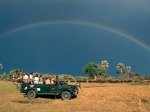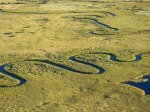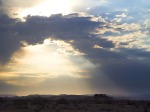Gillian and Tony Reeve have just got back from Botswana and wrote a few words on their safari for our Blog.
The highlight has to be the moment when we were flying over the Delta into our first camp when we both looked at each other and said one word that meant everything, ‘wow’. It was at this moment that we felt a bubbling of excitement in our bellies and began to unwrap our fabulous wedding present to each other, our safari.
When we landed we were greeted by Amos, his smile welcomed and settled us immediately. We drove into camp, at first not realising that we were on a ‘game drive’ that is until Amos pulled to a stop and pointed towards the bushes where poking out and giving the game away was an elephant’s back legs. We edged slowly forward and tracked around the bushes and thicket and there was a small herd of them gathered together in the shade snoozing and flicking tails. We wanted to stay rooted there for ages not realising that the days ahead of us would be a flurry of experiences such as this.
We pulled into our first camp and were welcomed by Kerry our host who handed us cool drinks, refreshing chilled flannels and had our bags taken to our tent. Wow again! The tent was fabulous, a four poster bed, soft linens, plump pillows, and soft rugs under foot, with an en-suite bathroom that puts many hotels to shame. This was certainly nothing like what you would normally describe as a tent! We had arrived and had enjoyed every minute just getting there.
How can one describe that everyday topped yesterday? On our first game drive the next morning we saw, Zebra and numerous antelope before enjoying a picnic lunch and a naughty glass of wine. After that we headed further afield to where Amos thought he had heard Lion earlier that morning and sure enough Amos was right. There shading against a tree trunk sat three lionesses. We could have sat there all day taking photographs and video, but eventually we tore ourselves away and went in search of the next find. More often than not we found something ‘more spectacular’ each time we drove onwards. We were in heaven. Thank goodness for digital cameras, our developing bill would have been astronomical. Thank you so much Opulent Africa, we had a superb honeymoon, and although we originally thought this would be a ‘once in a lifetime trip’ we are now not so sure.


